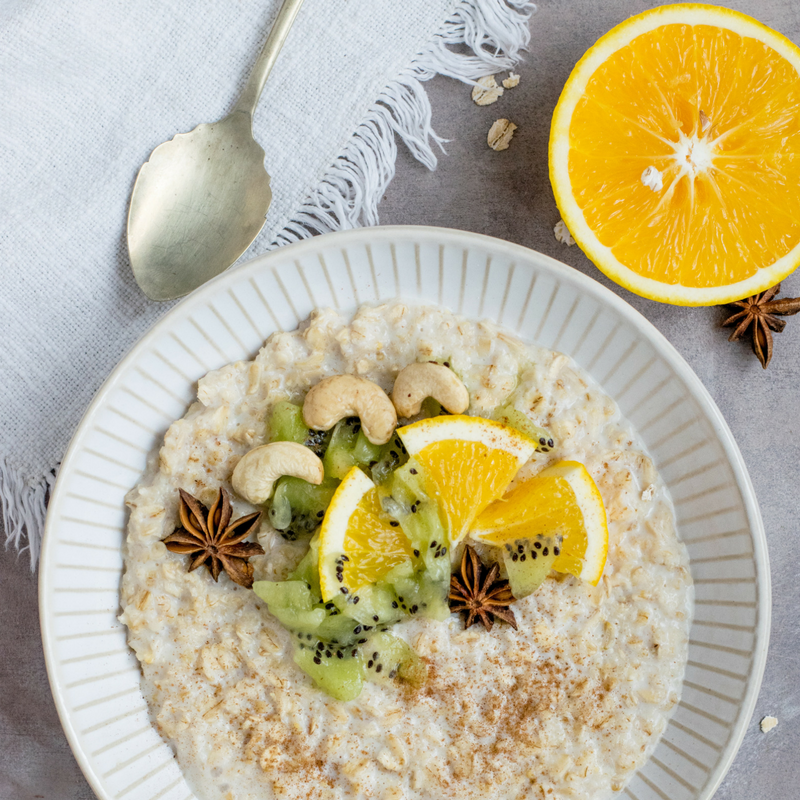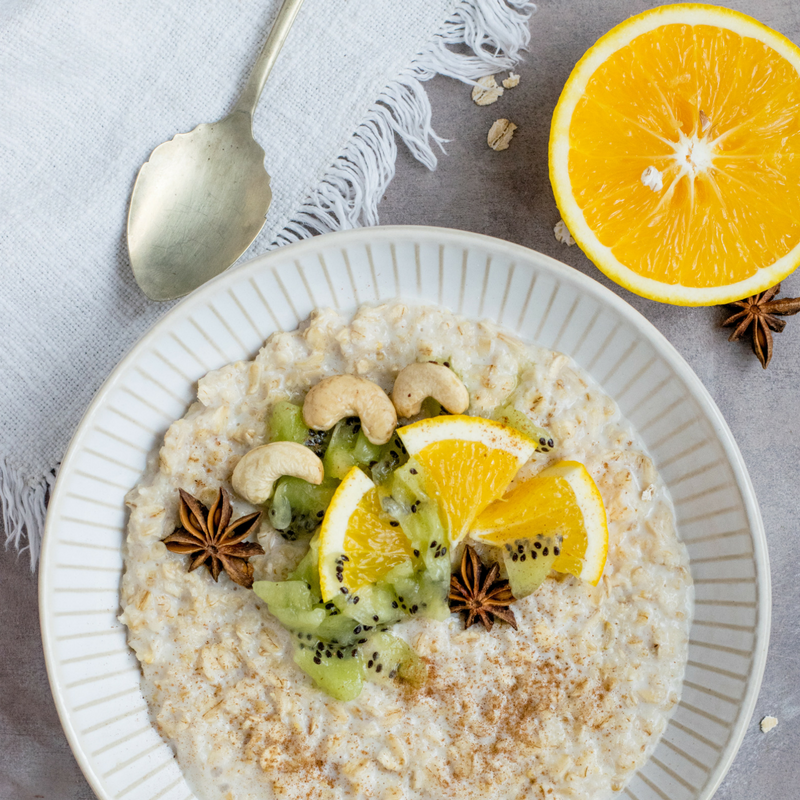June 17, 2019
What if you found out that there is an easy way to improve your current health, prevent or treat chronic disease, lose weight and enable your gut flora – your micro biome – to flourish, thereby reducing inflammation and improving immune function? Fiber. I know. Sounds boring and old school. But nothing could be further from the truth. Fiber, one of the most crucial dietary elements, hides in the shadows of the wholly misguided macronutrient debate of protein versus carbohydrates versus fats. Fiber should be leading the conversation.

A breakfast rich in fibre: oatmeal and fruit
The macronutrient way of looking at food is a great topic for another post. For today, know that approximately 100% of North Americans are far exceeding their daily protein requirements (even vegans exceed RDI for the most part).
Protein is not a deficiency in the developed world. The emphasis on ‘protein-everything’ has likely replaced a portion of the fiber on your plate. Fiber is a deficiency in the western world and one that brings with it huge health costs.
What exactly is dietary fiber? Fiber is a carbohydrate that contains no calories and passes through the digestive system undigested. It is found only in whole plant foods. Animal products do not contain fiber. Fats contain no fiber. The best sources are: fruits (not juice), vegetables, whole grains, legumes, peas, lentils, nuts and seeds, including chia seeds which have a massive 5.5 grams of fiber per tablespoon.
There are two kinds of fiber: soluble and insoluble. Both are amazing and necessary.
Soluble fiber
Such as oats, apples, legumes – most whole plant foods – easily binds with water to form a gel-like substance in the intestines. Soluble fiber is responsible for lowering LDL and total cholesterol levels thereby reducing cardiovascular disease. It also slows digestion thereby decreasing the rate of glucose absorption to help maintain proper blood glucose levels.
Insoluble fiber
Such as the bran layer of cereal grains or a high quality bran blend passes through the digestive system intact. This helps increase the efficiency of digestion, adds bulk to stools which keeps the colon healthy (think colon cancer) and prevents or treats constipation. It is also the food of your gut bacteria.

A warming curry, rich in fibre
Fiber is a disease prevention powerhouse while contributing to optimal body functioning. It reduces the risk of some cancers; helps with the maintenance of or loss of weight; lowers cholesterol; controls blood glucose levels; keeps you regular! This translates to prevention of, or assistance in treatment for, cardiovascular disease, diabetes, obesity, high blood pressure, constipation, at least some cancers, chronic inflammation and likely autoimmune diseases and alzheimers disease. But how does something that seems just like filler, become activated once swallowed? This is where your microbiome comes into play.
Fiber is the food of gut bacteria. It is the key to keeping our microbiome healthy and able to prevent the above-mentioned diseases. The fiber we obtain from food is digested by enzymes carried by microbes in our guts as their source of fuel/nutrition. Fiber is fermented by intestinal flora resulting in three main end products of which short chain fatty acids (SCFAs) are one. Briefly, look at one SCFA, butyrate, which is the preferred energy source for metabolism in the colon. Butyrate is thought to be the source of the anti-cancer properties we associate with fiber and is used in the treatment of ulcerative colitis. Pectin fibers (apples and citrus fruits) and legume fibers are the best sources for the gut to produce SCFAs. Without enough SCFAs, branched fatty acids, which are toxic, dominate.
The fact that fiber is the food of our gut bacteria should be a primary reason to make sure you have enough every day.
Without enough fiber, we are effectively starving our microbiome with serious short and long-term effects on our health. There have been several evidence-based scientific studies published in recent years. One, out of Georgia State University, put mice on a low-fiber, high fat diet and used feces to monitor their gut bacteria. The low-fiber diet caused the mice intestines to shrink and the mucus layer separating the intestine walls from the microbiome to thin thus triggering immune reactions. After just a few days, the low-fiber diet resulted in measurable chronic inflammation of the intestines. This translated quickly to weight gain and higher blood sugar levels. Diseases of western society – of the Standard American Diet.

A yummy salad that will help keep your fibre intake on point!
So how much fiber do we need? In North America, the average adult consumes about 15 grams of fiber per day. For an average male, the minimum number should be 38g (30g if over age 50) and for average females, 25-30g (21-25g if over 50). If active, consume even more. Current low intake levels are at a crisis point! The number of people with cardiovascular disease, diabetes, cancers, chronic inflammation, autoimmune disorders, and brain diseases is growing exponentially and afflicting younger people. This is largely a function of diet and the solution is so simple. What you eat and don’t eat (please rethink the word carbohydrate) makes all the difference. Count your grams of fiber and make sure you and your family consume enough every day.
Beautifully, fiber foods are also delicious and really easy to get enough of.
So what would a 30+g fiber day look like? 15g for breakfast of oatmeal with 1 tbsp chia and an apple stewed on top in the morning; raw and cooked vegetables with hummus in the day for at least another 10-20+ grams. Dinner – just half cup of lentils has 7.5 grams plus any vegetables, nuts or seeds on top. These elements will fill you up and provide other macronutrients and tons of energy as well. Building the foundation of your plate around whole plant fiber foods is quite simple.
Much love to your body!
If you enjoyed this blog, sign-up for our newsletter to receive future updates.
RESOURCES
1) Feed Good Gut Bacteria With… Fiber?
2) Fiber Is Good For You. Now Scientists May Know Why – Carl Zimmer
3) Short Chain Fatty Acids From Fiber As Critical Signals – Jon Lieff, M.D.
4) Fiber-Famished Gut Microbes Linked to Poor Health – Katherin Harmon Courage
5) Add These Fiber-Rich Foods to Your Diet to Fight Inflammation

Colleen Gray-Hewett, B.A.’93, UBC is a long-time North Vancouver, BC dweller whose passion for excelling at an active, healthy life well into her 40’s lead her to not only adopt, but intensively study the benefits of a plant-based diet. This lead to apprenticeships with key mentors such as Victoria Moran of Main Street Vegan Academy in NYC in 2016 and currently with Nicolette Richer of Richer Health (2017/18). Colleen always brings current strategies and ideas to her practice – be it with one-on-one coaching, writing or to speaking engagements. She strongly believes that we can prevent and heal our bodies with food.

Comments